July 2022 Invasive Plant of the Month
SICIM Email
Chinese yam (Dioscorea polystachya)
Chinese yam (Dioscorea polystachya Turcz.) is native to China and was introduced to the United States as an ornamental vine, food source, and for medicinal purposes. It is an aggressive, twining vine that can climb over 16 feet in height. It is thought to have escaped cultivation in the mid-1980’s and has spread across the southern and eastern United States. There are limited official records in Indiana, showing distribution primarily along the Ohio River valley, but undoubtedly Chinese yam is found in more places than currently reported. Chinese yam can spread rapidly in shady areas and is prolific in floodplains and riparian corridors. Due to the cinnamon like odor of the flowers, Chinese yam is sometimes called cinnamon-vine. It is often mistakenly called air potato which is another invasive plant species. Chinese yam is on the Terrestrial Plant Rule (312 IAC 18-3-25) which designates 44 species of plants as invasive pests and makes it illegal to sell, gift, barter, exchange, distribute, transport, or introduce these plants to the state of Indiana.
IDENTIFICATION & BIOLOGY: Stems: Stems are a perennial twining vine that is slender, wiry, and green in color. Sources suggest that the vine typically grows up the stems of plants in a clockwise direction. Leaves: Leaves are simple and up to 8 inches long. The leaves are alternate proximally (close to the ground) but can become opposite as they advance up the vine. The leaves are slender heart to fiddle shaped with pronounced parallel veins. Flowers: Small yellowish-white flowers arise for the axils of the leaves. The perianth (structure formed by sepals and petals) is bell-shaped and the staminate (male) flowers are in bundles, spikes, or panicles at the end of branches. Flowers may have a fragrance similar to cinnamon. Fruits: Chinese yam produces seeds in a three-angle membranous capsule but can also reproduce asexually via axillary tubers called bulbils.
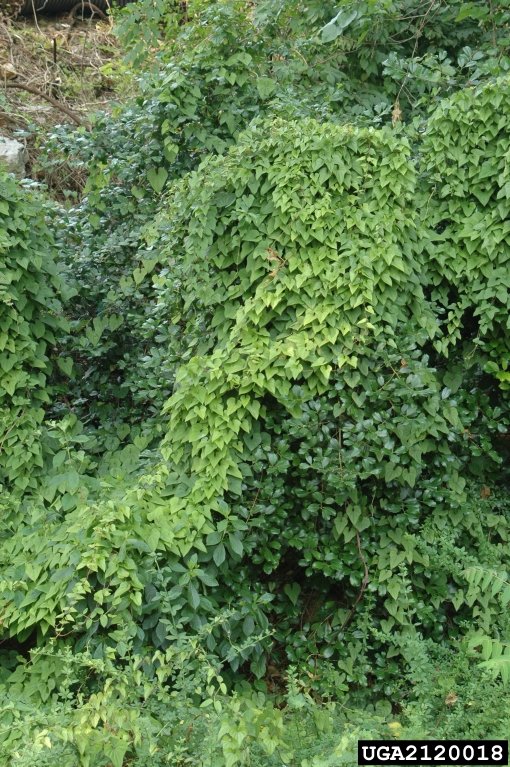
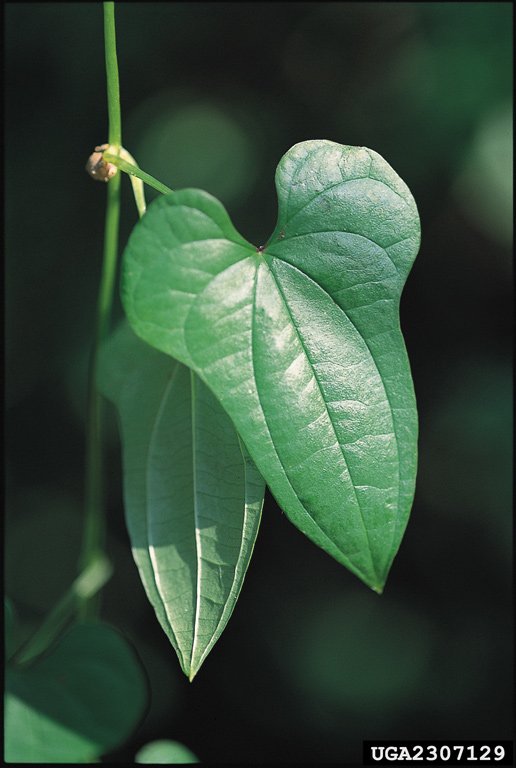
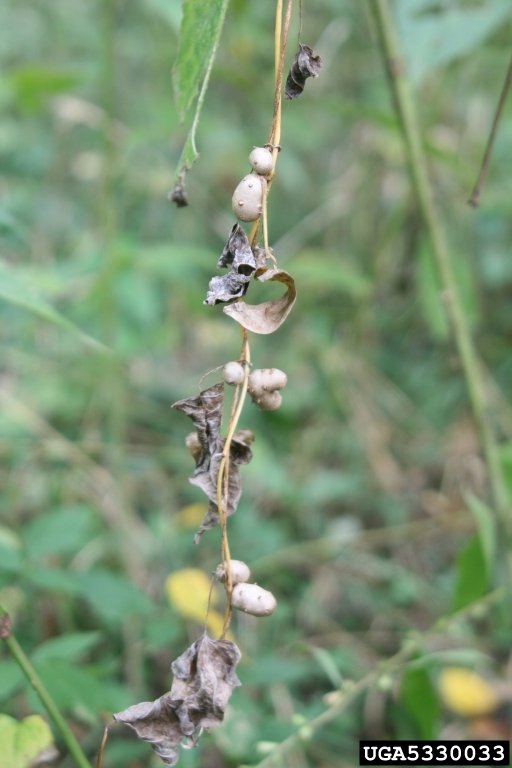
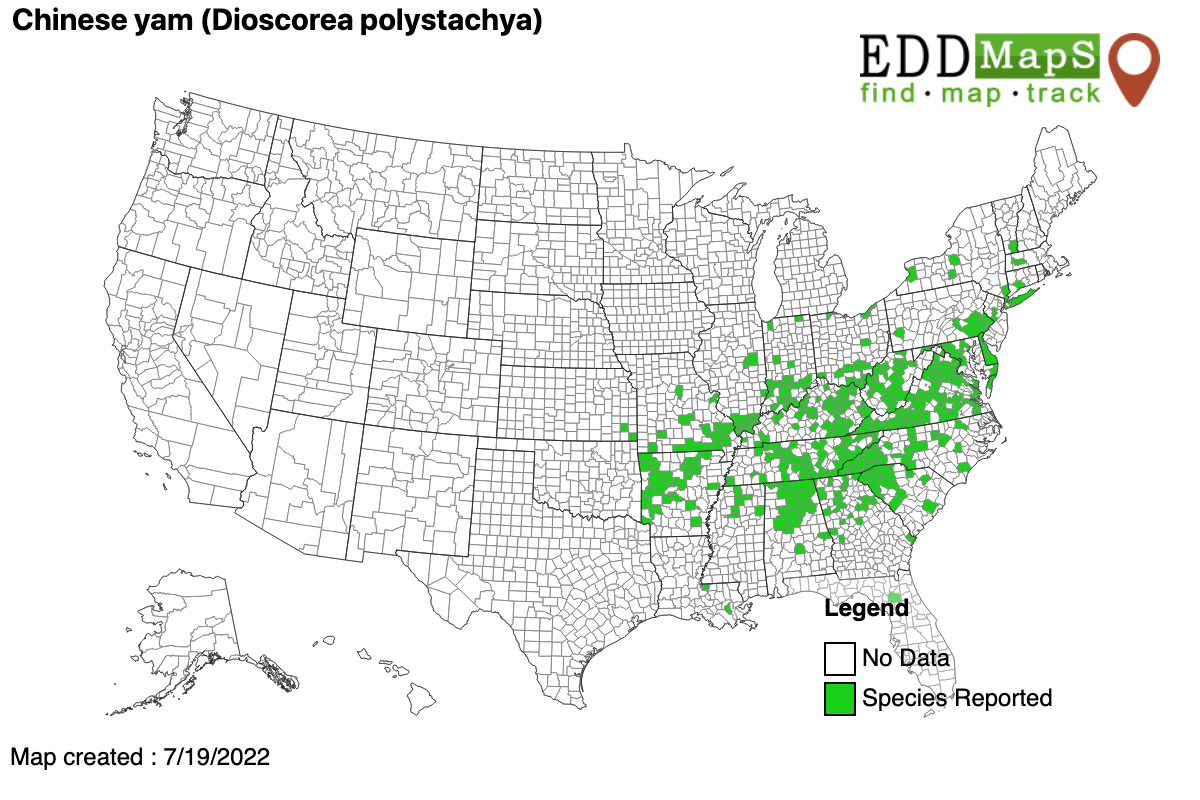
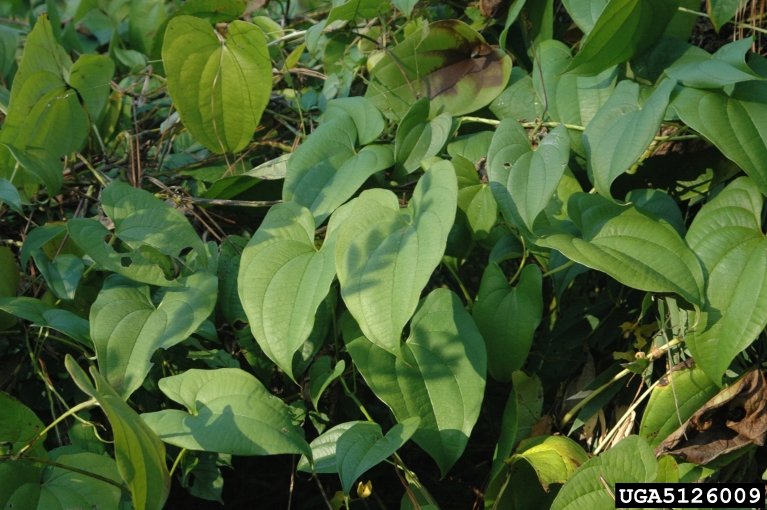
LOOK-A-LIKES: Some similarity to the native greenbriers (Smilax spp.), but greenbriers have thorns and green to purple berries with no aerial tubers. Chinese yam forms dense mats of vines whereas the native wild yam (Dioscorea villosa) does not form dense mats and does not produce aerial tubers (bulbils). Other non-native invasive vines that look similar include air potato (Dioscorea bulbifera), white yam (Dioscorea alata), and Dioscorea sansibarensis.
HABITAT & DISTRIBUTION: Chinese yam can survive in a wide variety of habitats but is the most aggressive along the edges of rich, mesic bottomland forests, floodplains, streambanks, and fence rows. The species favors disturbance, can survive full sun to full shade but prefers intermediate light levels of forest edges. Chinese yam can move into undisturbed, shady habitats. Chinese yam has not been shown to reproduce well from seed, but the asexual production of aerial tubers is responsible or the rapid spread of the species especially in riparian areas and floodplains.
ECOLOGICAL THREAT: Chinese yam can form dense mats or blankets of vines that overtop native vegetation and outgrow many native species. Chinese yam restricts light penetration to the forest floor and the weight of vines can break down shrubs and small trees. Once established in an area Chinese yam will displace native species, completely dominating layers within the forest and has limited value for wildlife. Chinese yam competes aggressively for sunlight and soil nutrients.
CONTROL: Like other invasive species, a combination of control tactics is necessary to manage Chinese yam. The most effective control is to prevent it from becoming established. A combination of manual and mechanical methods can be used to remove the stems and vines and prevent the production of aerial tubers. The large deep growing tubers can be removed manually, but fragments or root pieces left in the soil can sprout and develop healthy new plants. A combination of mechanical and chemical methods is typically the most effective. Foliar application of systemic herbicides (e.g., glyphosate or triclopyr) can be very effective, but care must be taken to limit damage to desirable species in the area. Foliar treatment can be successful in the spring through late summer. Treatment and monitoring an area for several years may be necessary to ensure that herbicide translocates to the tubers and eliminates them. Dormant bulbils may continue to sprout for several years making monitoring and follow up treatment critical.
IMPORTANT: The pesticide label is the law! When using any chemical control, always read the entire pesticide label carefully, follow all mixing and application instructions and use all personal protective gear and clothing specified. Contact the Office of Indiana State Chemist (OISC) for additional pesticide use requirements, restrictions or recommendations.
REFERENCES & OTHER RESOURCES:
https://www.invasive.org/gist/esadocs/documnts/diosopp.pdf
https://wiki.bugwood.org/Dioscorea
https://www.invasive.org/weedcd/pdfs/wow/chinese-yam.pdf
https://bugwoodcloud.org/mura/mipn/assets/File/Midwest%20Invasives%20Fact%20Sheets/PDF/yam.pdf
https://www.eddmaps.org/species/subject.cfm?sub=4527
LOOK-A-LIKE REFERENCES: